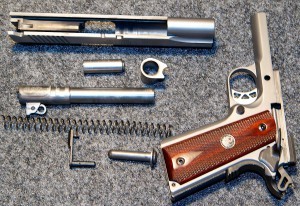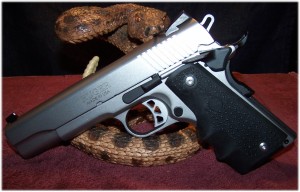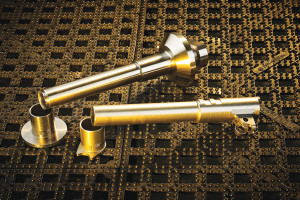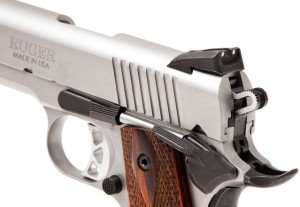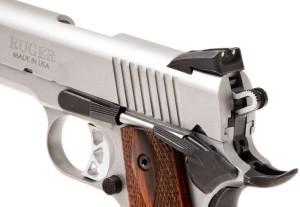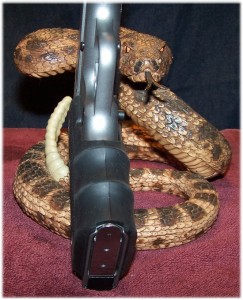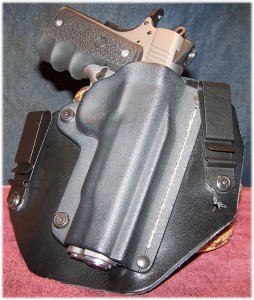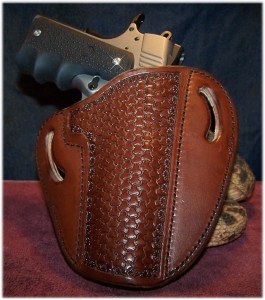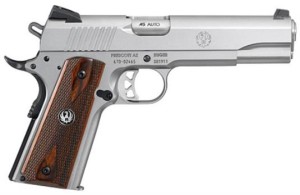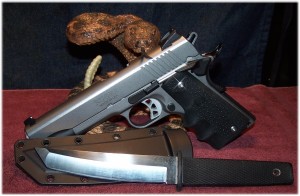While I have shot the P90 and P345, and do currently own an SR45, they lack the character of a good 1911-based pistol and I, for one, agreed that it was high-time for Ruger to step up to the plate and show us what Ruger could do with the basic M1911 and improve its design for the more modern pistolero. Moreover, come up with a 1911-based pistol that most of us could afford.
Ruger has always been known for providing the public with beefy and rugged firearms while keeping litigation lawyers at bay. I have always welcomed Ruger firearms in my home for many years because of their commitment to quality and for providing products that will last way beyond me. The SR1911 was introduced in 2011 (100 years after the M1911 was adopted as the pistol of the U.S. military), and was later followed by the SR1911CMD in January of 2013, and the SR1911CMD-A in January of 2015 (read my review of the SR1911CMD-A at: https://guntoters.com/blog/2015/08/25/rugers-sr1911cmd-a-is-an-a-winner/).
The 1911-based pistol is probably my favorite pistol, but this was Ruger’s first 1911-based product and I was not as eager to step into them as I thought I would be. I did consider jumping on the Ruger SR1911 bandwagon early on, but I let the initial products (and issues with them) run their course before one came into my possession. I also did my homework, watched scores of video reviews, and read way too many written reviews. My caution; however, was unfounded and the SR1911 has proved to be an admirable attempt by Ruger to enter into the 1911 fray. Because of my experience with the SR1911, I now own the SR1911CMD and the SR1911CMD-A, the latter of which I recently operated during the Bare Bones Gunfighting course (read my review at https://guntoters.com/blog/2015/12/25/bare-bones-gunfighting-and-in-shadow-in-light-a-training-course-review/).
I have owned the SR1911 since June of 2013.
Let’s first take a look at the SR1911 basic specifications and then I’ll get into some specifics of the pistol:
- Manufacturer: Sturm, Ruger & Co, Inc.; (603) 865-2442; www.ruger.com
- Caliber: .45 ACP
- Action: recoil-operated, center-fire semi-automatic pistol
- Frame: investment-cast stainless steel
- Barrel: forged stainless steel, 5″
- Rifling: six-groove; 1:16″ RH Twist
- Trigger Pull: single-action; 4 lbs., 8 oz.
- Sights: Novak Lo-Mount three-dot sights drift adjustable for windage
- Magazine: One 7-round and one 8-round stainless steel magazine
- Stocks: checkered wood with Ruger Medallion
- Overall Length: 8.67″
- Height: 5.45″
- Width: 1.34″
- Weight: 2 lbs., 7 oz.
- Accessories: zippered case, lock, manual, bushing wrench, chamber flag
- Suggested Retail: $939 (up from $799 when I first bought the pistol in 2013)
STYLING:
Original 1911 Series “70” design provides for easy take-down and re-assembly. The SR1911 has the same slim traditional design as the M1911 and comes with hardwood grip panels and checkered metal mainspring housing. I found out that the original SR1911 was to have rubber grip panels but was later changed to the wood with Ruger logo. The grip panels are standard .25-inch thick panels and afford a good gripping surface. Since I intend to carry the SR1911 at times, the grip panels were changed out for a Hogue Wraparound Rubber Grips with Finger Grooves 1911 Colt .45 9mm #C45-000 (see, RESOURCES) and mounted with Hogue Inc Colt Grip Hex head Screws Custom Stainless #45019 (see, RESOURCES) that add contrast to the stainless steel finish of the pistol. I prefer the Hogue rubber wraparound grips to many others when it comes to a handgun that I may have to fight with as my fingers fall right into the finger groves, the finger grooves add to the girth of the grip area, and (I feel) that I have much more control of the pistol. As a side note, I have a review of the Hogue Wraparound Rubber Grips with Finger Grooves 1911 Colt .45 9mm #C45-000 at https://guntoters.com/blog/2016/01/08/hogue-wraparound-rubber-grips-with-finger-grooves-1911-colt-45-9mm-c45-000/.MODERN MANUFACTURING:
Precision CNC-controlled machining process results in a superior slide-to-frame fit and smooth slide travel. The stainless steel barrel and bushing are produced from the same bar stock, on the same machine, for improved accuracy. Once completed, the barrel and bushing are installed as a unit.PERFORMANCE:
Positive barrel lock-up allows for a superior accuracy out-of-the-box. Over-sized ejection port and extended magazine release enhance magazine change performance (see also, RANGE Time).
TRIGGER AND HAMMER:
Lightweight, aluminum, 3-hole skeletonized trigger features adjustable over-travel and provides a very crisp, no creep, light trigger pull with a quick, positive reset. The skeletonized hammer is lightweight and provides faster cycling. When new, there is a little take-up, a slightly gritty wall, and the hammer falls with about 4.65 pounds to 4.75 pounds of trigger pull applied. After a short break-in, the trigger was feeling less gritty and trigger pull was coming at a smooth and crisp 4.6 pounds of pull. I like the trigger on this gun.
SIGHTING SYSTEM:
The rear sight is drift-adjustable and is held into the dovetail slot with a hex-head screw. On my particular pistol, there was no need for windage adjustments as the sights were spot on.
FRAME AND SLIDE:
Stainless steel frame and slide features a bead-blasted, low-glare finish and rear slide serrations for positive grip. The bead-blasted brushed finish of the pistol makes the SR1911 look classy without looking flashy. The slide-to-frame fit is as tight as I have seen and felt on a production pistol.
The plunger tube is also an integral part of the frame and is unlike other 1911’s where the plunger tube is staked to the frame. Although I have never had a plunger tube fail, with the SR1911 that is one issue I don’t have to even concern myself with.
Ruger did a good job in laser-etching the slide and frame with RUGER MADE IN THE USA etched on the left side of the frame and the Ruger “Eagle” etched on the right side of the frame. Some might question the need for “READ INSTRUCTION MANUAL BEFORE USING FIREARM” on the underside of the frame, but at least Ruger did not put it on top of the slide.
SAFETIES:
An over-sized beaver-tail grip safety with memory bump provides positive function and reliability. The grip safety is somewhat loose but not enough to be distracting unless you really demand a tight fitting grip safety. The grips safety works as it is supposed to; it allows the hand to get as high on the grip as possible, prevents the all too famous hammer bite, and allows you to fire the pistol with a proper handhold pressing it inward.The extended thumb safety and slide stop lever provides for improved, positive manipulation. Although the slide stop, thumb safety and magazine release button are extended, they are not obtrusive to the hand.
In keeping with the 1911 tradition, the thumb safety is mounted on the left side only. The thumb safety is over-sized for ease of manipulation.
The thumb safety is stiff when new. Some might consider it too stiff, but I would rather have my safety stiff than not. I do not ride the thumb safety when I shoot and would not appreciate it going “on safe” during a string of fire. As a side note, I do like ambidextrous safeties as I try to run a 1911 as much weak hand (left) as I can and an ambidextrous thumb safety is a great feature to have. With that said, I am not going to replace the thumb safety. I can also run a 1911 left-handed and know a few tricks about running the safety weak handed.
An internal safety feature is the use of a stiff firing pin spring and a lightweight titanium firing pin. This arrangement staved off the need for a firing pin block since the pistol can be dropped on the hammer and the firing pin will not reach the primer of a chambered round.
INTERNALS:
Internally, the SR1911 is well finished to include the feed ramp. Barrel lock-up is assured by more than adequate slots for the locking lugs of the barrel.
The barrel uses the classic JMB swing link design and is almost perfectly mated to the barrel bushing (nothing is perfect). I am not sure why Ruger chose to make the barrel bushing and barrel out of the same bar stock, but it seems to work just dandy. Perhaps, it has something to do with metal expansion rates or something, which is beyond my engineering knowledge. The barrel is throated to reliably feed hollow-point ammunition, and the feed ramp is polished.
Although I would not consider it a safety, which is something that I consider as an item that prevents the pistol from going boom when you don’t want it to, a visual inspection port on top of the chamber allows for visual confirmation that chamber is loaded. This negates the need for performing a “press check” that I have never felt the need to do; if the slide is forward, I consider it loaded until I prove otherwise.
No, Martha! The Ruger SR1911 does not have a magazine disconnect safety.
MAGAZINES:
The Ruger SR1911 ships with two stainless steel magazines; one seven-round flush fit, and one 8-round magazine with a bumper pad. While the magazines are quality and they work well in the Ruger SR1911, I have found that they do not work well in some other 1911-based pistols. It seems that the slot in the magazines for the magazine catch is somewhat shorter than that found on other magazines. This may cause the magazine to drop out of a non-Ruger pistol under fire. However, Wilson Combat and Meg-Gar magazines work well in the Ruger SR1911. My advice is to plan on purchasing quality magazines, although the provided magazines worked well in the Ruger SR1911 and could be used for range duty.
VISUAL IMPACT:
The SR1911 is a very cleanly finished pistol. There are no front serrations or fancy sculpturing and the eight rear serrations are nicely blended into the pistol while providing a good purchase for the hand. All edges are nicely finished.The front and rear sight, extended magazine release button, slide lock, hammer, thumb safety, beaver-tail grip safety, extractor button, and checkered metal mainspring housing and all pins are black and contrast nicely with the stainless steel frame and slide. With the addition of the Hogue wraparound rubber finger groove grips, there is a nice balance in the overall look of the pistol. Actually, the pistol looks more like the original SR1911 concept with the rubber grips, but with the additional finger grooves.
The SR1911 uses the traditional straight barrel and bushing arrangement and utilizes a standard Recoil Spring Guide and Plug, which keeps the front end looking clean and mean. I have no intention of changing the guide rod system to a one-piece guide rod.
Although the metal mainspring housing is checkered, the front strap is clean of serrations. The Hogue Wraparound Rubber Grips with Finger Grooves covers this area and provides my shooting hand with a little more grip area to hold onto; I like a slightly over-size grip area.The long, aluminum skeletonized trigger is nicely done and has a flat, serrated surface that I like. The edge of the trigger indexes right into the first joint of my shooting finger, which is where I prefer a trigger to be on full-sized handguns. The trigger also incorporates an over-travel adjustment screw, but blends well with the trigger. The trigger area is also relieved for the trigger finger of either hand.
From the right side, the lowered and flared ejection port provides a nice escape for expended shell casings and extracting and expending shell casings is something that the SR1911 does well as Ruger has beefed up the internal extractor for positive extraction.
Overall, the SR1911 is a clean looking, visually-appealing 1911-based pistol. It has features that would be considered custom in the past but are now considered standard fare. The quality is built in and there should be no doubt about that.
HOW IT CARRIES:
Regardless of how pretty or ugly a pistol might look; one of the important aspects is how a pistol carries on the body. If the SR1911 is to be a range or bedside table gun, carrying it is of no importance. However, to those who wish to pack a full-size 1911-based pistol (like myself) how to best carry one is a prime consideration.
The SR1911 is not a light pistol with 2.7 pounds (unloaded) bearing down on your belt. Carrying the SR1911 needs a very good support system. Since I am used to packing “heavy” it is no bother to me, but it could be if you are not used to carrying something that could carry you to the bottom of a lake in no time (you need not worry; however, the SR1911 is stainless and won’t rust before they pull you out of the water).
Whether you carry IWB or OWB, a good belt is an absolute necessity for concealment purposes. I prefer a pancake-style holster for OWB. If I am carrying openly, one of my requisites is that the holster has a thumb-break for security reasons. If I am carrying concealed under a garment(s), I prefer an open-top holster with nothing to interfere with the thumb safety.For IWB carry, I like an IWB holster that will protect the entire forward end of the pistol. I also prefer an IWB holster without a sweat guard, which will provide my shooting hand full access to the grip and thumb safety when drawing the pistol from the holster.
I like the grip area to be pulled tightly into my side regardless if I am carrying IWB or OWB and, so far, a modified SHTF Gear ACE-1 Gen 2 Holster (http://www.shtfgear.com/)that has substantial Kydex to protect the 5-inch barreled Ruger SR1911 has met my expectations for IWB carry. The holster is modified in that the sweat guard has been removed and I have added a little more forward cant to the holster to keep the butt of the pistol forward, which helps to blend the full-size grip of the SR1911 (or any pistol for that matter) into my side. For OWB carry, a fine holster from Leather Creek Holsters (http://www.leathercreekholsters.com/home.html) fits the bill (it was made locally by an expert leather smith) and I hope to have another of his fine holsters in the near future to fit my single-action Uberti revolvers). Of course, the holster choice for the 1911-based pistol is wide, varied, and a personal choice, but it must be a good choice.
To accommodate the weight of the SR1911 pistol and also two spare 8-round magazines of 230-grain hollow point ammunition, I also wear suspenders. This is, of course, a personal choice but one that has worked for over twenty years of carrying a pistol on my side (before then, I actually had hips and a butt).
To carry the SR1911 IWB, it also means wearing a t-shirt to prevent the butt of the pistol from rubbing against bare skin and from getting moisture during the hot summer months of the South from getting to the pistol (regardless of what I am carrying at the time). Some folks welcome the sweat shield on most IWB holsters, as it does what it means. However, and especially with a 1911-based pistol, I don’t want any possible interference with the operation of the thumb safety or my thumb getting to it during the draw stroke. I normally position the thumb on the shooting hand above the thumb safety during the actual draw stroke. When the gun is in the proper firing position, and I am ready to fire, the thumb safety is pushed off-safe. When I am holstering the pistol, the thumb of my shooting hand is below the thumb safety and applies pressure to it during holstering until the pistol is completely holstered. A sweat shield would interfere with this operation.
The SR1911 is a hip gun; it needs to be riding on the hip (or just behind it) to get the full support you need to carry this beast. Some may recommend a shoulder holster, but I do not. Most shoulder holsters could affect thumb safety operation by flipping the safety off safe during the draw, and that is something that I want to control and not relinquish it to a holster. The SR1911 is a heavy gun and if you are used to carrying one of those lightweight polymer wonders, the weight of the pistol will take getting used to – a lot of getting used to. But, carrying a full-sized 1911-based pistol can be carried effectively, and has been done, by better men than I.
RANGE TIME:
I am not going to write that the Ruger SR1911 is capable of placing 50-rounds in a sub-MOA group at 100 yards. Neither the pistol, nor am I, is capable of that feat. The Ruger SR1911 is not, after all, a target pistol. Most custom 1911s will shoot groups half the size or smaller but cost three or four times as much as the Ruger. The Ruger SR1911 is a highly effective personal defense pistol, packs plenty of punch, and is one of the best 1911-based pistols that I have fired given the affordability aspect of the pistol.The length of the barrel and the weight of the pistol equate to better accuracy, more punch to what ammunition you are shooting, and less recoil when shooting it over a lighter, shorter-barreled 1911-based pistol with or without a laser. I have proven that to myself and to other shooters.
The trigger, when new, was at first a little gritty but that has smoothed up after use and 4.6-pounds of trigger pull feels really good. A little take-up and a crisp break with no over-travel. No adjustment needs to be made to this pistol’s trigger for defensive use.
I have no problems taking out the red “X” area of a standard silhouette target at 15-yards with the SR1911 while shooting from a modified “weaver” stance. Beyond that distance I really need to brace the pistol to be that accurate, although I could put all shots on target probably and hold them in the 9-ring of a standard silhouette target. That is not a reflection of the SR1911, but more of a reflection of my capabilities as I get older.
One day at the range, and luckily on a day that I had the SR1911 with me, one of my shooting companions had brought a new shot timer with him. Now, I am not a fast pistol shooter by any means. I thought why not see how fast I could pull off my modified “Mozambique” drill with the SR1911. That is; 3 shots CM, 2 shots H, and 3 shots back to CM at 10 yards. From first shot to last, the best time I could do so was a hair under 3.5 seconds with all shots on target (starting from the “High Ready” position). Not “pro” times, but I am not a pro; just your average shooter with some experience. Yeah, I would carry the SR1911 as my PDA (Personal Defense Assistant). I kiddingly ask him to bring the timer back when I had one of my Uberti single-action revolvers and I would run the standard Mozambique drill with one of those.
The SR1911 now has about 350 rounds through it with nary a hitch. Not a lot of rounds in two years and not a torture test by any means, but enough to tell me that the SR1911 is a pistol that I could count on.
SUMMARY:
With an MSRP of $939, and at today’s prices, the Ruger SR1911 cost a tad more than the Rock Island Armory Pro Match Ultra 5” 45ACP (MSRP $862), less the Springfield Armory 1911 Loaded (MSRP $962 for the Stainless Steel version), less than the Remington Arms 1911 R1 ENHANCED STAINLESS (MSRP $999), and somewhat north of the ROCK Ultra FS – 45 ACP (MSRP $722). However, my cash and carry price for one was $646.00 out the door with all tax, titles, and fees paid for. This; however, was in 2013 and today my price is a little bit higher if I chose to purchase another one ($699 cash and carry). If you shop around, you can find the Ruger SR1911 for a decent price.I consider the Ruger SR1911 as an investment, as I do any firearm. The Ruger SR1911 is within reach of most of us mortals, and being mortal, one has to consider their choice of carry firearms (and other firearms) very carefully. There are very few firearms that I would consider having two and it usually comes down to cost and quality for the cost. I would purchase a second Ruger SR1911 for that reason.
If you are not concerned about cost, there are many fine 1911-based pistols out there and many gun shops that will be happy to take your money. If you are budget-conscience, like most of us are, then affordability is a prime concern when deciding to purchase a pistol for sport, HD, or SD and the Ruger delivers in that area along with Ruger quality in their products and after-purchase customer-service. I would not have the SR1911, the SR1911CMD, and the SR1911CMD-A if I thought otherwise, nor would I recommend them to you.
A lot of folks, experts in their own minds, classify the SR1911 as an “entry-level” pistol because it is not a high priced Les Baer, Ed Brown, Wilson Combat, Night Hawk Custom, or even a Kimber or Sig Sauer. Compared to what we had available to us in the not too distant past, the SR1911 is more like a full-featured near custom pistol.
And, you have to ask yourself, if John Moses Browning designed the 1911 with the features that it has today, what would we have left to improve upon? I can live with an “entry-level” pistol like the Ruger SR1911.
RESOURCES:
- http://www.ruger.com/products/sr1911/specSheets/6700.html
- Hogue Wraparound Rubber Grips with Finger Grooves 1911 Colt .45 9mm #C45-000: http://www.amazon.com/Hogue-Wraparound-Rubber-Grooves-C45-000/dp/B00VQJFICY/ref=sr_1_1?ie=UTF8&qid=1451408878&sr=8-1&keywords=Hogue+Wraparound+Rubber+Grips+with+Finger+Grooves+1911+Colt+.45+9mm+%23C45-000
- Hogue Inc Colt Grip Hex head Screws Custom Stainless #45019: http://www.amazon.com/Hogue-Screws-Custom-Stainless-45019/dp/B0010XDK2Q/ref=sr_1_1?ie=UTF8&qid=1451408933&sr=8-1&keywords=Hogue+Inc+Colt+Grip+Hex+head+Screws+Custom+Stainless+%2345019
- Hickock45 Ruger SR1911 Video Review: https://www.youtube.com/watch?v=CAZ5EYxpl2o
- Hickock45 Ruger SR1911 Chapter 2: https://www.youtube.com/watch?v=Tq56NfLY-Es
- Jeff Quinn Review and Video: http://gunblast.com/Ruger-SR1911.htm
- Video Review by Crucible Arms: https://www.youtube.com/watch?v=AmfdPHtlKSQ and https://www.youtube.com/watch?v=L2dZKXSj1Vo
![]()



